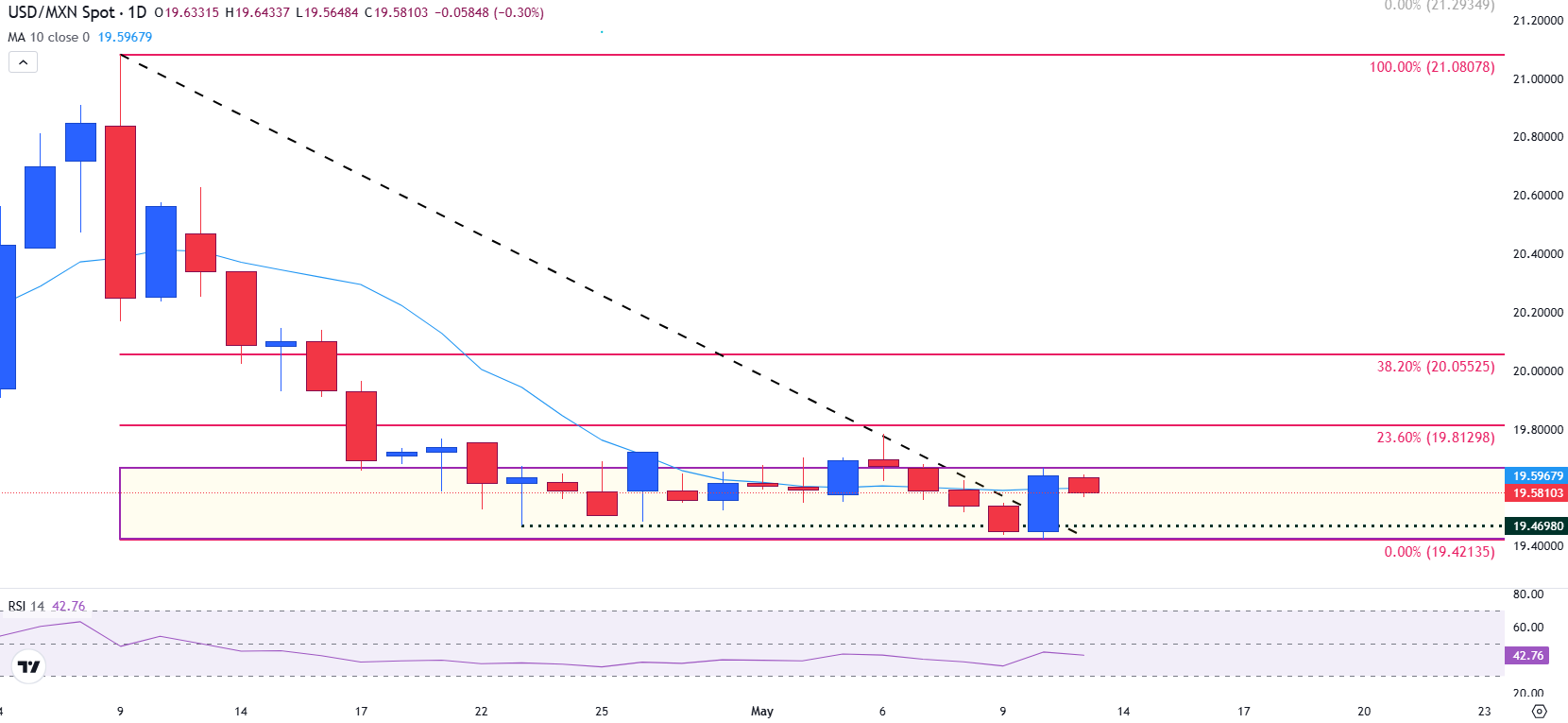Mexican Peso strengthens on improved global risk sentiment ahead of US inflation data
- Mexican Peso edges higher as markets adopt a risk-on tone before key macro events affecting the USD/MXN pair.
- The US CPI report due Tuesday is expected to show stable inflation, shaping rate cut expectations.
- USD/MXN holds above trendline resistance as traders wait for the next Fed cue.
The Mexican Peso (MXN) is trading higher against the US Dollar (USD) on Tuesday as a rebound in global risk sentiment supports emerging market currencies ahead of a key macroeconomic week. At the time of writing, USD/MXN is trading around 19.578, down 0.30% intraday.
Traders are positioning cautiously before the release of the US Consumer Price Index (CPI), due later on Tuesday, and the Bank of Mexico’s (Banxico) interest rate decision on Thursday, both of which could significantly impact USD/MXN direction in the short term.
US CPI report to set the tone for Fed outlook
The April US Consumer Price Index (CPI) report, due Tuesday, is expected to show a 0.3% MoM increase in both headline and core inflation.
On a yearly basis, headline inflation is projected to hold steady at 2.4%, while core Inflation, which excludes food and energy, is seen remaining unchanged at 2.8%. These figures are critical for shaping expectations around the Federal Reserve’s (Fed) next policy move.
According to the CME FedWatch Tool, markets continue to price in that the US central bank will cut rates by 25 basis points in September, but that outlook remains highly sensitive to inflation data. A stronger CPI print could delay those expectations, while a softer reading may solidify the case for an earlier cut.
The inflation release will be followed later this week by a series of Fed speeches, including comments from Governors Waller, Jefferson, and Daly on Wednesday, and Chair Jerome Powell on Thursday. These appearances could offer further insight into whether the Fed is committed to holding rates steady or preparing to shift toward a more dovish stance.
Banxico is expected to continue on a dovish path
The Bank of Mexico (Banxico) is widely expected to cut its benchmark interest rate by 50 basis points to 8.5% at Thursday’s policy meeting.
According to a Reuters poll published on Monday, 30 out of 31 economists anticipate this outcome despite inflation remaining near the upper bound of Banxico’s target range. In its most recent statement, the central bank signaled that further significant rate adjustments could be considered in upcoming meetings, provided inflation dynamics allow.
As Banxico continues its easing cycle while the Federal Reserve holds rates steady, the narrowing interest rate differential between Mexico and the United States typically dampens the appeal of peso-denominated assets for yield-focused investors. However, the Peso’s recent strength suggests this divergence may already be largely priced in, with markets now turning their attention to forward guidance and broader external risk sentiment.
Mexican Peso daily digest: US CPI and Banxico decision in focus
- A 0.50% rate cut by Banxico on Thursday would mark the third consecutive cut of this size and the seventh straight rate cut since the central bank began its monetary easing cycle in June 2024. The decision is driven by a continued moderation in inflation, which currently stands at 3.93%, within Banxico’s target range.
- The Mexican economy remains under pressure, another factor that supports interest-rate cuts. Mexico’s Gross Domestic Product expanded 0.2% in Q1, following a contraction in the previous quarter, while March industrial output showed only a modest 1.9% year-over-year increase.
- Mexico’s Finance Minister Edgar Amador stated he is "reasonably confident" about the Treasury’s fiscal and growth projections for the year, forecasting a healthy 1.9% growth in 2025, contrary to the estimates of a near stagnation, according to most analysts.
- With the Fed keeping interest rates elevated while Banxico moves toward easing, capital flows continue to favor US-denominated assets. This dynamic adds sustained downward pressure on the Peso.
- Longstanding 25% US tariffs on Mexican steel, aluminum, and automobiles have raised production costs and weakened Mexico’s export competitiveness, particularly in the manufacturing sector, a key engine of economic activity.
- On Sunday, the US Department of Agriculture announced a 15-day suspension of cattle, horse, and bison imports from Mexico due to the spread of the New World screwworm. The measure will be reviewed monthly based on containment progress. Mexican President Claudia Sheinbaum criticized the suspension as “unfair,” citing its economic impact on agriculture. While not a major driver of peso weakness on its own, the ban contributes to broader trade uncertainty.
- Mexico and the US are preparing for an early review of the United States-Mexico-Canada Agreement (USMCA), originally scheduled for 2026 and now likely to begin later this year. The review may reshape trade rules, tariffs, and labor terms, increasing uncertainty around future economic conditions.
- Stronger commodity exports – particularly Oil and agricultural goods – offer some support, but are insufficient to offset the Peso's structural headwinds from policy divergence, trade tensions, and shifting capital flows.
Technical analysis: USD/MXN pauses above prior trendline resistance
USD/MXN continues to trade within a narrow consolidation range, holding between key support at the April low of 19.42 and resistance at 19.60-19.65, which also aligns with a descending trendline from last month’s highs.
Despite several intraday attempts, the pair has recently failed to break above this ceiling. A sustained move beyond 19.60 could open the door toward the 23.6% Fibonacci retracement level of the April-May move at 19.81, followed by the 38.2% level at 20.06.
However, downside risks remain if support at 19.42 gives way, potentially exposing the pair to further losses toward the 19.30-19.20 region. The 10-day Simple Moving Average (SMA), currently around 20.22, is sloping lower and reinforces the prevailing bearish momentum.
USD/MXN daily chart

Meanwhile, the Relative Strength Index (RSI) sits at around 43, indicating weak bullish pressure and a market still biased to the downside. Overall, the short-term outlook remains neutral to bearish unless the pair decisively breaks above the 19.60 resistance zone.
Economic Indicator
Consumer Price Index (MoM)
Inflationary or deflationary tendencies are measured by periodically summing the prices of a basket of representative goods and services and presenting the data as The Consumer Price Index (CPI). CPI data is compiled on a monthly basis and released by the US Department of Labor Statistics. The MoM figure compares the prices of goods in the reference month to the previous month.The CPI is a key indicator to measure inflation and changes in purchasing trends. Generally, a high reading is seen as bullish for the US Dollar (USD), while a low reading is seen as bearish.
Read more.Next release: Tue May 13, 2025 12:30
Frequency: Monthly
Consensus: 0.3%
Previous: -0.1%
Source: US Bureau of Labor Statistics
The US Federal Reserve (Fed) has a dual mandate of maintaining price stability and maximum employment. According to such mandate, inflation should be at around 2% YoY and has become the weakest pillar of the central bank’s directive ever since the world suffered a pandemic, which extends to these days. Price pressures keep rising amid supply-chain issues and bottlenecks, with the Consumer Price Index (CPI) hanging at multi-decade highs. The Fed has already taken measures to tame inflation and is expected to maintain an aggressive stance in the foreseeable future.
Inflation FAQs
Inflation measures the rise in the price of a representative basket of goods and services. Headline inflation is usually expressed as a percentage change on a month-on-month (MoM) and year-on-year (YoY) basis. Core inflation excludes more volatile elements such as food and fuel which can fluctuate because of geopolitical and seasonal factors. Core inflation is the figure economists focus on and is the level targeted by central banks, which are mandated to keep inflation at a manageable level, usually around 2%.
The Consumer Price Index (CPI) measures the change in prices of a basket of goods and services over a period of time. It is usually expressed as a percentage change on a month-on-month (MoM) and year-on-year (YoY) basis. Core CPI is the figure targeted by central banks as it excludes volatile food and fuel inputs. When Core CPI rises above 2% it usually results in higher interest rates and vice versa when it falls below 2%. Since higher interest rates are positive for a currency, higher inflation usually results in a stronger currency. The opposite is true when inflation falls.
Although it may seem counter-intuitive, high inflation in a country pushes up the value of its currency and vice versa for lower inflation. This is because the central bank will normally raise interest rates to combat the higher inflation, which attract more global capital inflows from investors looking for a lucrative place to park their money.
Formerly, Gold was the asset investors turned to in times of high inflation because it preserved its value, and whilst investors will often still buy Gold for its safe-haven properties in times of extreme market turmoil, this is not the case most of the time. This is because when inflation is high, central banks will put up interest rates to combat it. Higher interest rates are negative for Gold because they increase the opportunity-cost of holding Gold vis-a-vis an interest-bearing asset or placing the money in a cash deposit account. On the flipside, lower inflation tends to be positive for Gold as it brings interest rates down, making the bright metal a more viable investment alternative.

